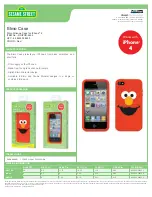
88
Safety Guidelines
evaluated as in compliance with the FCC RF emission
guidelines. SAR information on this model phone is on
file with the FCC and can be found under the Display
Grant section of http://www.fcc.gov/oet/fccid after
searching on FCC ID BEJC2000.
Additional information on Specific Absorption Rates
(SAR) can be found on the Cellular
Telecommunications Industry Association (CTIA)
website at http://www.wow-com.com
*In the United States and Canada, the SAR limit for
mobile phones used by the public is 1.6 watts/kg
(W/kg) averaged over one gram of tissue. The
standard incorporates a substantial margin of safety
to give additional protection for the public and to
account for any variations in measurements.
Hearing Aid Compatibility with Mobile
Phones
When some mobile phones are used near some hearing
devices (hearing aids and cochlear implants),users may
detect a buzzing, humming, or whining noise. Some
hearing devices are more immune than others to this
interference noise, and phones also vary in the amount
of interference they generate. The wireless telephone
industry has developed ratings for some of their mobile
phones, to assist hearing device users in finding phones
that may be compatible with their hearing devices. Not
all phones have been rated. Phones that are rated have
the rating on their box or a label on the box. The ratings
are not guarantees. Results will vary depending on the
user’s hearing device and hearing loss. If your hearing
device happens to be vulnerable to interference, you
may not be able to use a rated phone successfully.
Trying out the phone with your hearing device is the
best way to evaluate it for your personal needs.
M-Ratings:
Phones rated M3 or M4 meet FCC
requirements and are likely to generate
less interference to hearing devices than
phones that are not labeled. M4 is the
better/higher of the two ratings.
LG2000 RSA ENG_02.14 2006.2.15 5:34 PM
˘
` 88







































